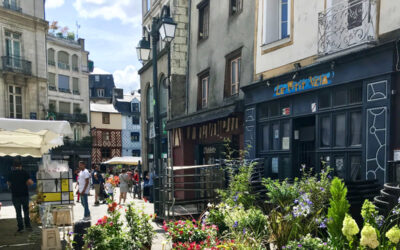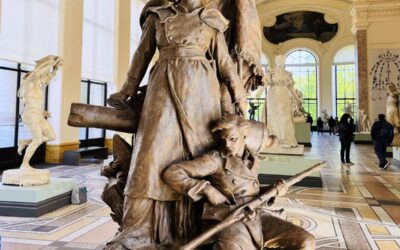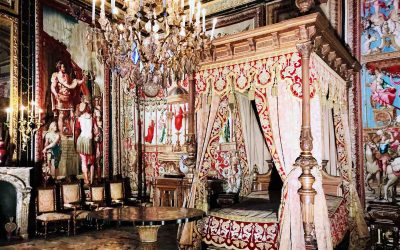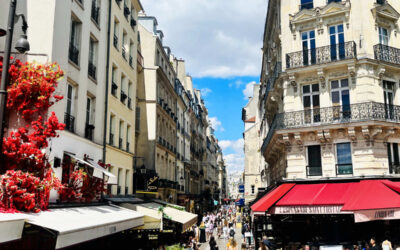Visiting the Assemblée Nationale is only for the brave few. That is the brave and hardy few who are willing to queue for 4-6 hours.
France’s version of the House of Representatives, called the Assemblée Nationale is only open to visitors one day a year, unless you get a special dispensation from your French député (parliament minister). The annual event, called the Journée du Patrimoine, is held all across France in mid-September, to let French people and tourists go behind closed doors, to those places that are usually inaccessible.
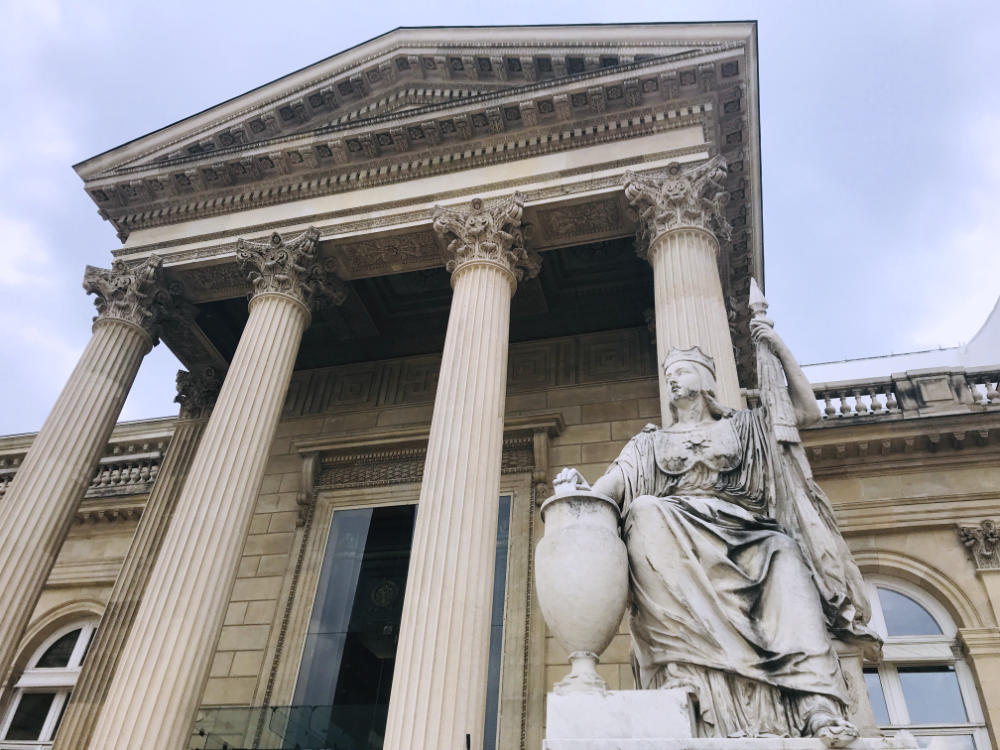
As you may guess, the Assemblée Nationale located in Paris in the 7th arrondissement is one of the most popular, leading to long lines of people waiting. Unless you are lucky enough to score a timed ticket as I did! (There is no science to it, it involves pure luck and timing on the Assemblée website.)
The Hémicycle
Like the United States, the French Government has a President, a House of Representatives (House of Commons to Brits), and a Senate. It is the House of Commons that today sits in the Assemblée Nationale in what is called the Hémicycle.
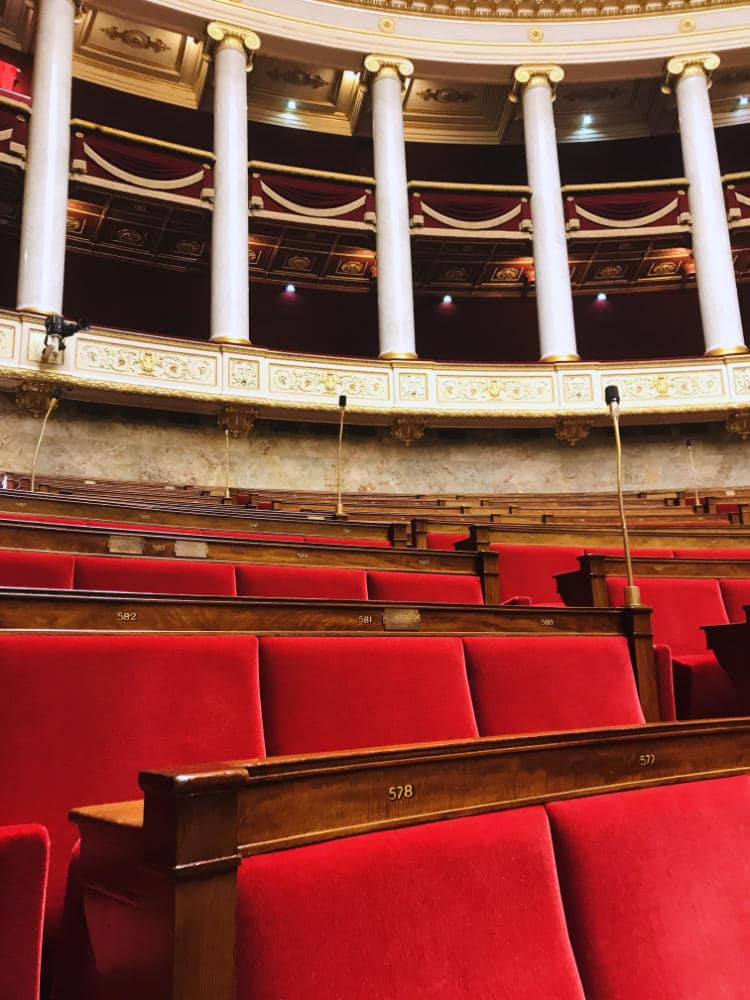
A large room that is in the shape of a 1/2 circle, it seats over 500 députés representing the different regions of France. Left-leaning parties sit on the left, and right-leaning parties sit on the right.
You can just imagine the French National Anthem playing as you want into this room.
Similar to the British Queen, the President of France is not allowed to visit the Assemblée Nationale unless he is invited. Instead, he appoints a Prime Minister to lead his party within the Hémicycle. (I say he because to date there has never been a French female President.)
In addition (assuming he has the largest number of seats in the Hémicycle), he also gets to appoint the President of the Assemblée Nationale, which is similar to the “Speaker of the House” that North Americans and Brits are familiar with.
☞ READ MORE: 250+ France Fun Facts: By the Numbers

As in those countries, the President presides over the debates and votes from his “perchoir” (perch) above the députés, trying to keep the order.
With its famous glass-domed roof and red-velvet seats, the Hémicycle is considered the heart of French democracy, where the majority of significant events in the history of France have occurred following the French Revolution in 1789.
The right to vote for women, abolish slavery, etc. most major events in French history have been debated and voted on in the Hémicycle. Infamously, it was also the site where a bust of Hitler and the German Reich flag were put up during the invasion of France in World War II which you can see here.
Palais Bourbon
Located in the building that was once called Palais Bourbon (the junior name of the French royal family), the Assemblée Nationale is actually a lot larger than it looks from the outside.
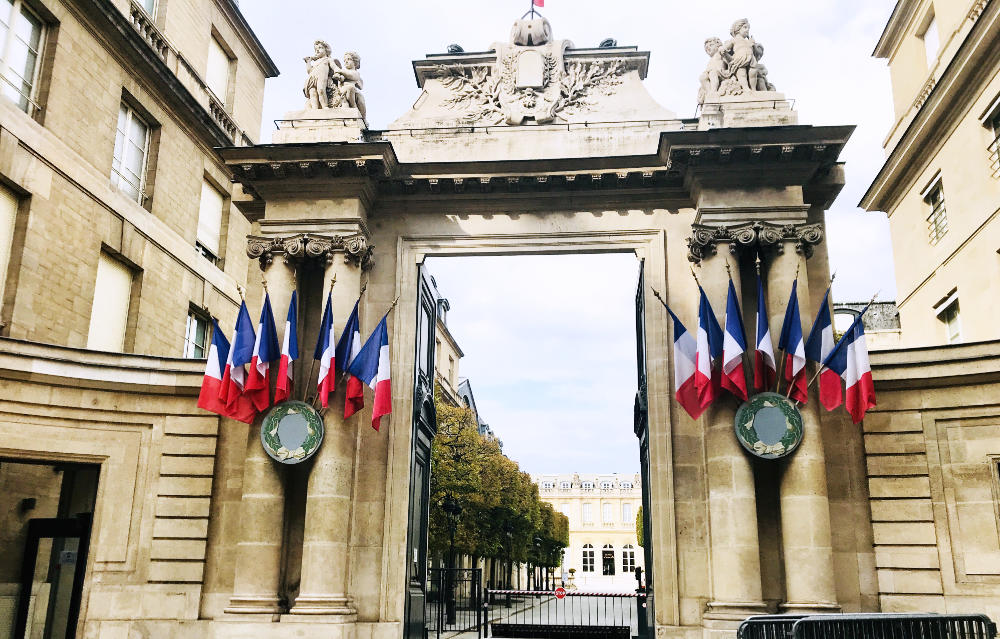
It is actually a series of interconnected buildings, most of which were constructed by the illegitimate daughter of the Sun King Louis XIV, Louise Françoise. King Louis and his favorite mistress, Madame de Montespan, adored their daughter and both openly recognized her.
Being the King’s daughter, he gifted her with a large dowry and married her off at the age of 12 to one of his cousins, the Louis de Bourbon, Prince of Condé.
The marriage was an unhappy one, even though she did have 9 kids with him. Luckily for our Louise Françoise, her husband died when she was in her 30s and she was now able to control her own fortune.
With her newly minted independence, she constructed a new home on the quays of the Seine, acquired many lovers (more on this later), and enjoyed a long widowhood at what was then called “Palais Bourbon“.

☞ READ MORE: “Vive La France” and other French Presidential Vocabulary
The area that Louise started her construction in 1722 was at the time mostly swampland, on the edge of Paris’s city center. It would soon become one of the most fashionable areas of town called Faubourg Saint Germain (today Saint-Germain-des-Prés).
Having grown up at the Palace of Versailles which was constructed by her father, Louise based many of her designs on the Grand Trianon in Versailles.
One of her lovers, the Marquis de Lassay shared her love of architecture and purchased the property adjacent. The two buildings were constructed at the same time, almost connecting. Today, this adjacent building, which is called the Hôtel de Lassay, is the public residence of the President of the Assemblée Nationale.
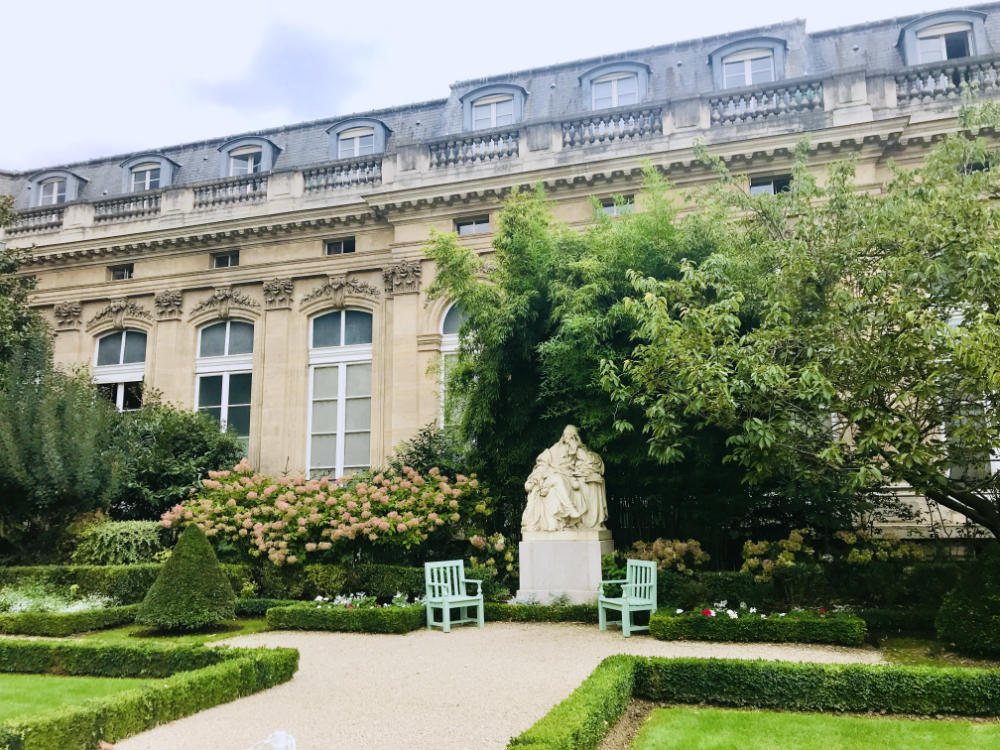
After Louise and the Marquis de Lassay died, King Louis XV (the Sun King’s grandson) purchased the buildings from her heritors. The building was nationalized during the French Revolution, eventually becoming the seat of the Council.
When Napoleon Bonaparte took control, he decided to strip back some of the Assemblée’s powers, but did give it a new majestic Roman facade with giant columns à la Julius Caesar. You can read more about French history here.

It is this facade that is today most recognizable as the front of the Assemblée Nationale on the Seine, although in reality, nobody enters from there. It is the large courtyards and gates at the back of the buildings that is the actual entrance for security purposes.
Salle des 4 Colonnes
Inside the main building of the Assemblée Nationale is one of the most familiar rooms to French people, the Salle des 4 Colonnes (“Room of 4 Columns”).

It serves as a backdrop on French nightly news for press interviews with ministers and other government officials, each trying to make their point at the expense of the opposition.
The hall has 4 large columns with large reliefs dedicated to the députés lost fighting during World War I and World War II on each side. It also features 2 large busts: left-wing Socialist Jean Jaures on one side, and his right-wing Christian counterpart Albert de Mun.
Salle des Pas Perdus
The Salle des Pas Perdus (“Room of Lost Steps”), just off the Hémicycle, is another one of the important ceremonial rooms of the Assemblée.

It is through this room that the President of the Assemblée enters the Hémicycle from his residence at the Hôtel de Lassay, with Republican guards forming a haie d’honneur on each side as he enters.
The room itself is rather plain, with a large bronze statue of Minerve, the Goddess of Law and Justice against one wall.
It is the ceiling that is the masterpiece in this room, covered in a series of classical paintings, including Lady Peace holding an olive branch.
Galerie des Fêtes
After the President of France, and the Prime Minister, the President of the National Assemblée is the most important man in France. So you know he has to have a room to party(!) and/or greet foreign dignitaries.
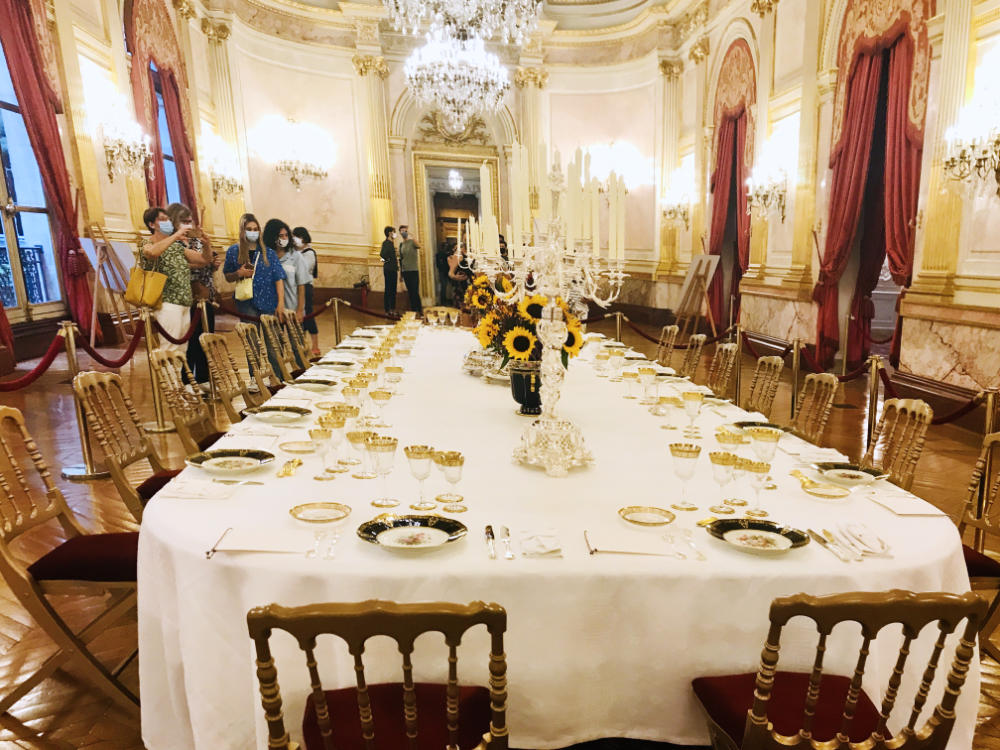
It is in the Galerie des Fêtes that many of those soirées are held, featuring the best of French cuisine and savoir-faire.
☞ READ MORE: Quiz: Do you know your French Geography?
And just off the Galerie des Fêtes is the office of the President of the Assemblée in easy access, should the President need to look at his notes during an important meeting. (I say he, because there has never been a female President of the Assemblée either.)

The Library
The most beautiful room in the Assemblée Nationale has to be the Library. Portions of the ceiling were painted by Eugene Delacroix, the famed painter of the famous painting of Liberty leading the people.
(If you enjoy Delacroix’s work, head over to the Musée Delacroix which is just footsteps away from the Assembly in the 6th arrondissement.)

The library is not usually open to the public as it is reserved for deputies, their collaborators, and officials of the Assembly. It holds many classical treasures and important documents in French history dating back to the ages.
Even the 15th-century court process of Jeanne d’Arc is kept here, in a safe on the premises. Like the rest of Assemblée Nationale, it is only open to visitors and researchers on special occasions.
If you have been to the library at Château de Chantilly, you will be hard pressed to decide which one is more beautiful (and/or which one holds more important documents).
Other Meeting and Reception Rooms
There are various other reception rooms off of the Galerie des Fêtes that serve to welcome foreign dignitaries and government officials. You can see the elaborate Versailles influence very clearly in these rooms. They were clearly meant to impress.

Even the conference room for the deputés and ministers is highly decorated. Unlike the Palais de l’Elysée, which is where the President of France resides, these rooms are usually not redecorated every time a new President of the Assemblée is appointed.
Most Presidents of the Assemblée only serve 2-3 years so turnover is quick. Still pretty good though!
☞ READ MORE: 40 Things to do on that Ultimate Trip to Paris


So are you ready to queue up to visit the Assemblée Nationale and the seat of French democracy? If you enjoyed that article, you may like to read more about visiting the Palais de l’Elysée, the official residence of the President of France. A bientôt!

